
After a two-year break to await new products, the Autocar tyre test is back - bigger and better than ever. This year we began, as usual, by choosing two of the very few cars awarded five stars in an Autocar road test. For the family car sector we picked Ford's brilliant Focus 1.8, shod with standard 195-55 R15 tyres. For the high-performance category we chose the storming Subaru Imprezza Turbo, which uses 205/50 R16s.
We also took a Caterham 1.6 Clubsport along to test specialist tyres ranging from a full slick to a competition remould. Like the tyres fitted to the Ford and the Subaru, these are applicable across a wide range of other cars.
Last time we tested the two tyre categories at different tracks. This time we went to Goodyear's magnificent Mireval proving ground in the South of France for all three, allowing us to compare the tyre groups directly.
This isn't just the best tyre test Autocar has conducted. We reckon it's the best you'll read anywhere, but then you'll be the ultimate judge of that.

|
This test produced an unexpected result: as a group, the family car tyres out-performed the high performance tyres in wet braking.
Whereas the winning family size 195/55 R15 - the Goodyear - braked from 50mph to 31mph in an average 24.5m, the best high performance 205/50 R16 (the Goodyear) could only manage 27.6m, a massive 13 per cent difference.
Even the worst tyre in the narrower, family car category - the Dunlop - beat the loser in the high performance sector (the Dunlop again) by over 3.6m.
Before you start thinking the Focus outbraked the Impreza, note that Goodyear's own Audi A4 workhorse was used for this test, not the Subaru.
In fact there's good evidence to show that, in practice, the Impreza was significantly better at wet braking than the Focus. Take :a look at the g-g plots from the accelerometer and you'll see that the Subaru on the high performance Goodyear braked much quicker into the wet handling circuit's tight hairpin than the Ford could manage on Goodyear's narrower tyre.
So the message is: ignore the absolute figures and concentrate on the ranking order. Hot on the heels of the shortest-stopping tyre, the Goodyear, comes the Bridgestone, followed closely by the Pirelli and, less closely, by the Michelin and the Continental.
Again, the Dunlop fairs worst, by an even larger margin than the narrower tyre did in the family car test. In fact, over 6m separates first and last - a huge 23 per cent disparity.

Four of the six tyres here - Bridgestone, Dunlop, Goodyear and Pirelli - have directional tread patterns to help them remove water more effectively from the contact patch.
These postpone the point at which a wedge of water lifts them clear of the road, causing the car to aquaplane.
It works like this: instead of throwing water forward and back into their own path, the special tread ejects more of it sideways, out of harm's way. So, by rights, they ought to star here.
They do, especially the comfortably victorious Goodyear, which postpones aquaplaning to a speed almost 3mph faster than the second-placed Bridgestone. The Pireill is close behind, with the Dunlop further adrift, but clear ahead of both the Michelin and Conti.
When it comes down to shifting water, the wide circumferential grooves of the latter two can't compete with the others' V-shaped treads.
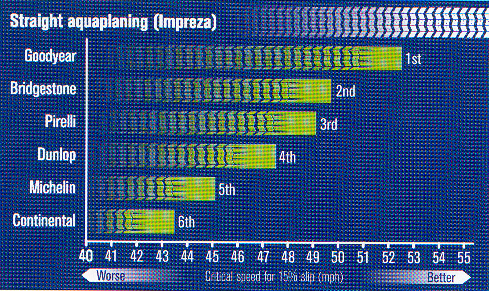
As we pointed out in the Focus section, aquaplaning in i straight line and in a curve make different demands on a byre. Good results in one doesn't necessarily mean similar results in the other.
Here's more evidence of that. Although the top three tyres are the same as above, they now appear in reverse orden This time it's the Pirelli that's victorious and the Goodyear third, with the second-placed Bridgestone making a convincing claim to having the best balanced aquaplaning performance.
One surprise is that the directional Dunlop this time succumbs to the ordinary Michelin - a final ignominy for a tyre that flounders in the wet. Last place for the Conti proves its dislike of standing water.
From the raw data, we can tell you these tyres were generally superior to those fitted to the Focus. But the best tyre of all was the family class Goodyear, capitalising on its narrow width.

First on to the Impreza is the Bridgestone. It performs well, but not as well as we were expecting. There's quite a lot of sliding, but it's of the predictable, usable variety, so long as you keep the power flowing to the road.
Back off in the wrong place, however, and the tail will snap away more quickly than it does with some of the other tyres fitted. The Bridgestone is good-ish under braking and through the medium-speed corners, but overall it's not the towering performer we'd hoped for.
Experience of the Goodyear on the Focus has us expecting a strong performance from the wider version here. We're not disappointed. The Goodyear feels very predictable and very safe through the S-bends, shifting standing water more effectively than any other tyre.
This is borne out by a very tight set of lap times, which is always a sign of a friendly, predictable tyre. The Subaru is prone to understeer anyway - even in the dry - but on the Goodyear it understeers more in slow corners than we expected.
More impressive is the way you can brake extremely late for the hairpin. Even a heavy right foot fails to trigger the anti-lock brakes.
Next up is the Michelin - a pretty disappointing tyre. It's less predictable and not as capable as shifting standing water as the opposition, turning what should be a set of safe, effortless laps into a fairly hair-raising experience.
The Michelin's one good side is its performance under braking. It's not as sharp as the Goodyear but is considerably better here through the S-bends. The Pirelli tested here is a lot better than the one fitted to the Focus. It's not as wayward as the Michelin but is still unable to match the precision and predictability of the Goodyear and Bridgestone.
In between the Pireill and Michelin, we can slot the Continental. It's not quite as poor as the Michelin but not far off it. It manages very similar lap times but still seriously lacks grip and predictability.
Just when we thought the Michelin and Continental had set the base level for our group of tyres, we slipped a set of Dunlops onto the Impreza's wheel rims.
This tyre provided us with our slowest lap times, but figures alone don't tell the full story. The Dunlop has a lack of wet grip that makes the Impreza a real handful pretty much everywhere on the circuit, not just through the S-bends.
You have to brake very early for the hairpin, too, and even then it's all too easy to activate the anti-lock and slither straight on. Not a strong performance from the Dunlop.
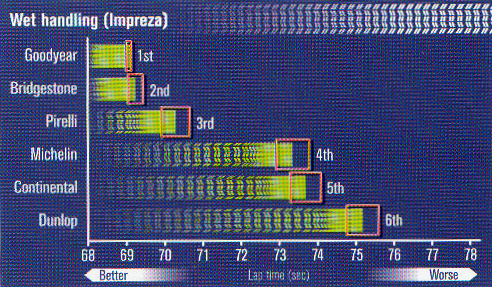
This is the first time we've subjected tyres in the high-performance category to a rolling resistance test, so it's the first opportunity we've had to see how they compare with the less extreme tyres fitted to the Focus.
High-performance tyres aren't designed with fuel economy to the fore, of course, but any tyre designed to withstand continuous running at high speed has to carefully control heat build-up in its tread area, otherwise it could disintegrate.
Low heat build-up requires low energy absorption, so it's no surprise to discover the rolling resistance figures for these tyres aren't as bad as you might at first suppose.
In fact, the best tyre in this category, the Conti, has a rolling resistance that's only 12 per cent worse than the winning Michelin in the family car test, and a mere two per cent down on the Conti in the same test.
Further down the table, though, matters become significantly worse. Dunlop's last-placed tyre, for instance, has a 19 per cent higher rolling resistance than the trailing tyre in the family car category, making it a very poor choice for the penny-conscious customer.
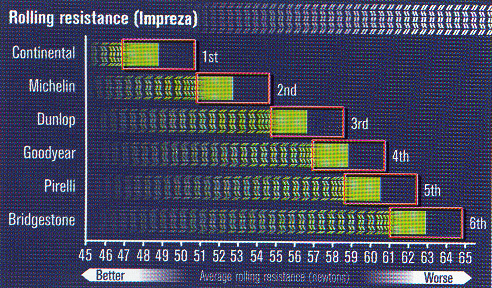
In our last tyre test back in 1997, it was difficult to compare coast-by noise figures for the two categories of tyre because they were measured at different tracks.
Despite both sites conforming to the relevant international standard, noise figures are notoriously variable when measured at different venues.
This time, though, both tyre categories were tested on the same track surface and under very similar weather conditions, so comparisons are easier to draw.
And, given that the high-performance tyres are only 10mm broader, there's really very little difference between the two categories.
In fact, the results grouping is tighter than in the family car category, the winning Dunlop being a little noisier than the best in the Focus test, while the wooden-spooner - the Goodyear - is slightly quieter than the worst of the narrower tyres.
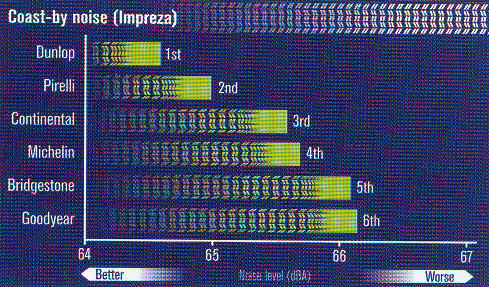
Consistency versus raw speed: it's always the key to discovering the dry handling performance of any tyre. In this case it's especially marked, given that the slowest tyre (the Dunlop) is also the easiest to be consistent with.
The Dunlop's performance deteriorates the least over five flying laps, so although loose on the turn-in compared with the others and delivering the lowest mid-corner grip, at least its characteristics don't change dramatically as the laps go on. This means we can lap within a couple of tenths of a second time after time.
What lets the Dunlop down compared with the competition is its relative lack of bite under brakes. This is most obvious when slowing for the chicane at the end of the pit straight, where the Impreza's anti-lock brakes kick in earlier than with any other tyre fitted.
If we aren't very careful, terminal understeer will also allow the nose to wash wide of the apex in the chicane. The only remedy is to brake sooner and more gently.
Next up is the Goodyear, which feels crisper and generally grippier than the Dunlop over the first two and a half laps, but fades rapidly from this point on. Admittedly it recovers toward the end of the lapping, presumably having simply overheated under the strain in the middle.
But this is still not a towering performance from the host tyre, even though the Impreza feels sharper turning into and braking for corners than it had with the Dunlop on board.
Separating the Bridgestone from the Pirelli should have been easy but isn't. The Bridgestone initially feels sharper and grippier, particularly through fast corners. But unfortunately it goes off sooner than the Pirelli, which never feels quite as keen as the Bridgestone when fresh but sustains its performance for longer. This explains the more consistent laps on the Pirelli.
The quickest tyre is the Continental, thanks to its fractionally superior bite under brakes and during high-speed turn-in. But the best tyre, subjectively, is the Michelin.
Though we aren't able to lap as quickly outright with the Michelin fitted, it nevertheless makes the Impreza feel more dynamic, and just plain better balanced than with any other tyre. The Continental comes close but only really beats it for balance through the really quick parts of Mireval's dry track.
In the slow stuff, the Michelin squeals with the best of them but it also reduces the Impreza's natural understeer more effectively than any rival.
In a car as prone to washing away from corner apexes as the Subaru is, that's a key advantage as far as we're concerned.
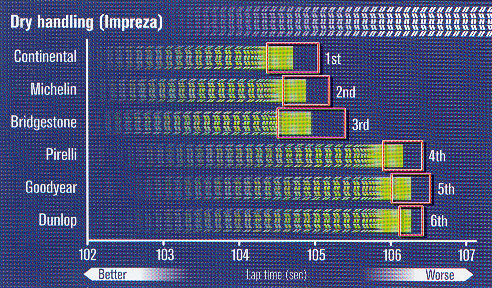
This is the fourth time we've tested high-performance tyres and, despite using narrower rubber than we've tested previously and a four-wheel-drive car, the established pattern remains.
The first year, Goodyear's Eagle Fl won. The second time, the newly launched Bridgestone Potenza S-02 scored a narrow victory over the Goodyear. Next year Bridgestone and Goodyear were again virtually inseparable, and here it's the same old story. Formula l's old enemies are still slogging it out at the top, with Pirelli in close contention.
The others are far enough behind to rate as also-rans. You might consider the Michelin or Continental for their fine handling in the dry, but why would you when the Bridgestone is about as good in the dry and so much better in the wet? Had Michelin's directional Sport XGT been available as a 205/50 R16 things may have been different, but the ageing, non-directional MXM can't cut it in the wet, and neither can the mildly asymmetric ContiSportContact.
The Dunlop, sadly, has nothing to commend it save its low coast-by noise, which is hardly enough to endear it to drivers concerned more with performance and safety.
For a directional tyre it is particularly disappointing in the wet, suggesting that Dunlop's compounding expertise falls significantly short of its rivals'.
Although the Bridgestone and Goodyear tie on points, the Japanese tyre is the better all-rounder, with the Goodyear pipping it in the wet. The Pireill is almost as good on rain-soaked asphalt but, like the Goodyear, loses its edge in the dry.
So the Bridgestone, in its latest Pole Position variant, gets our vote once again. It's the best performance tyre you can buy. But pick any of the top three and you're unlikely to be disappointed.

Lap times and braking distances are never exactly the same for each tyre every time you measure thern.
This means that, to compare one tyre reliably with another, it isn't sufficient simply to take the average result for each; you also have to account for the inherent variability in the measurements. This is how tyre and car makers conduct their tests and, unlike our competitors, that's how Autocar does it too.
We account for the variability in results by means of confidence intervals, represented by the red outlines behind each bar in the charts. These are calculated using standard statistical methods and allow us to say with 90 per cent certainty that, had we repeated each test many times without the conditions changing, the average of the results would fall within this range.
The practical outcome is much easier to understand than the maths. If two tyres' confidence intervals do not overlap, we can conclude that the test has found a genuine difference. If they do overlap, we can't be certain of a disparity.